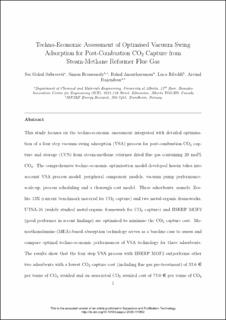| dc.contributor.author | Subraveti, Gokul Sai | |
| dc.contributor.author | Roussanaly, Simon | |
| dc.contributor.author | Anantharaman, Rahul | |
| dc.contributor.author | Riboldi, Luca | |
| dc.contributor.author | Rajendran, Arvind | |
| dc.date.accessioned | 2021-07-07T13:13:56Z | |
| dc.date.available | 2021-07-07T13:13:56Z | |
| dc.date.created | 2020-10-02T14:40:56Z | |
| dc.date.issued | 2020 | |
| dc.identifier.issn | 1383-5866 | |
| dc.identifier.uri | https://hdl.handle.net/11250/2763807 | |
| dc.description.abstract | This study focuses on the techno-economic assessment integrated with detailed optimisation of a four step vacuum swing adsorption (VSA) process for post-combustion CO2 capture and storage (CCS) from steam-methane reformer dried flue gas containing 20 mol% CO2. The comprehensive techno-economic optimisation model developed herein takes into account VSA process model, peripheral component models, vacuum pump performance, scale-up, process scheduling and a thorough cost model. Three adsorbents, namely, Zeolite 13X (current benchmark material for CO2 capture) and two metal–organic frameworks, UTSA-16 (widely studied metal–organic framework for CO2 capture) and IISERP MOF2 (good performer in recent findings) are optimised to minimise the CO2 capture cost. Monoethanolamine (MEA)-based absorption technology serves as a baseline case to assess and compare optimal techno-economic performances of VSA technology for three adsorbents. The results show that the four step VSA process with IISERP MOF2 outperforms other two adsorbents with a lowest CO2 capture cost (including flue gas pre-treatment) of 33.6 € per tonne of CO2 avoided and an associated CO2 avoided cost of 73.0 € per tonne of CO2 avoided. Zeolite 13X and UTSA-16 resulted in CO2 avoided costs of 90.9 and 104.9 € per tonne of CO2 avoided, respectively. The CO2 avoided costs obtained for the VSA technology remain higher than that of the baseline MEA-based absorption process which was found to be 66.6 € per tonne of CO2 avoided. The study also demonstrates the importance of using cost as means of evaluating the separation technique compared to the use of process performance indicators. Accounting for the efficiency of vacuum pumps and the cost of novel materials such as metal–organic frameworks is highlighted. © 2020 Elsevier B.V. | en_US |
| dc.language.iso | eng | en_US |
| dc.publisher | Elsevier | en_US |
| dc.rights | Attribution-NonCommercial-NoDerivatives 4.0 Internasjonal | * |
| dc.rights.uri | http://creativecommons.org/licenses/by-nc-nd/4.0/deed.no | * |
| dc.title | Techno-economic Assessment of Optimised Vacuum Swing Adsorption for Post-Combustion CO2 capture from Steam-Methane Reformer Flue Gas | en_US |
| dc.type | Peer reviewed | en_US |
| dc.type | Journal article | en_US |
| dc.description.version | acceptedVersion | en_US |
| dc.source.volume | 256 | en_US |
| dc.source.journal | Separation and Purification Technology | en_US |
| dc.identifier.doi | 10.1016/j.seppur.2020.117832 | |
| dc.identifier.cristin | 1836637 | |
| dc.relation.project | Norges forskningsråd: 257579 | en_US |
| dc.source.articlenumber | 117832 | en_US |
| cristin.ispublished | true | |
| cristin.fulltext | postprint | |
| cristin.qualitycode | 1 | |

